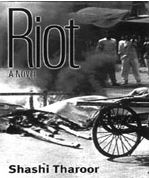Passion and Politics
By Emile Chabal | Arts & Culture | Books | Published 23 years ago
 The often alarming proximity of love, hate and history is richly drawn out in Shashi Tharoor’s latest novel Riot. Set amidst the vicious sectarian clashes in north India in 1989, it tells the story of an American student’s commitment to help local women, her passionate affair with the local district magistrate, and her untimely death, days before she was due to return to the US.
The often alarming proximity of love, hate and history is richly drawn out in Shashi Tharoor’s latest novel Riot. Set amidst the vicious sectarian clashes in north India in 1989, it tells the story of an American student’s commitment to help local women, her passionate affair with the local district magistrate, and her untimely death, days before she was due to return to the US.
The book opens with a (fictitous) newspaper article informing us of the death of a postgraduate student named Priscilla Hart. She was working for the NGO, HELP-US, encouraging female birth control in the small town of Zalilgarh in Uttar Pradesh. From there, Tharoor takes us backwards. He uses myriad styles to create a whodunnit jigsaw puzzle, except that here the reader is the detective. Through transcripts, cables, newspaper articles, poems, hastily scribbled notes and secret diaries, the reader is invited to piece together the events surrounding her death.
We meet her divorced parents who struggle to comprehend why anyone would want to kill the daughter they never quite understood. We are offered transcripts of conversations with a historian — who seeks to explain the roots of sectarian hatred — and the Hindu community leader who stokes the flames of that same hatred. We meet the Sikh police chief who attempts to control the riots and Lakshman, the district magistrate who finds himself caught between his emotional ties to Priscilla and his professional commitment to the police force.
Finally, there is Priscilla Hart herself. Here Tharoor’s characterisation is particularly vivid. An intelligent student from an affluent, middle-class background, she is drawn back to India after spending several years there as a child. When she returns with the NGO, HELP-US, she embarks on her mission to ‘emancipate’ the women of Zalilgarh with a naive, almost missionary, fervour.
Quite rightly, Tharoor avoids any simplistic moral judgements. Priscilla’s cause is worthy but fraught with difficulties. In some cases where she wishes to help, she succeeds only in making things worse. The implication is clearly that, while the west often wants to help, it must tread carefully and seek to understand the host culture before it barges in with its own ideas.
The quest to understand India is another important aspect of this book. India’s multiple identities are a cause of much of the hatred between communities, and nowhere has this been made plainer than in the controversy over the Babri Masjid. Though the novel is set in 1989, before its destruction in 1992 by Hindu fundamentalists, the Ram Sila Poojan programme to rebuild the mosque forms the backdrop to the novel.
From the Hindu leader’s rants against “those secularists in Delhi” to the historian’s plea that he wishes his son to grow up in an India “…neither Hindu nor Muslim, but both,” we are constantly reminded that little takes place in India that is devoid of ‘historical’ meaning. The book’s most potent message seems to be one of unity. The only way forward is for India’s distinct communities to remember that, ultimately, they are Indian above all else.
If the politics provides the book’s message, the love affair between the district magistrate, Lakshman, and Priscilla gives the book its forward momentum. Though the ‘love-in-adversity’ theme is a time-worn one, it is augmented in this case by the clash between Lakshman’s upper-middle class Indian upbringing and that of a modern western girl. Endearing details like Lakshman’s obsession with Wilde help to give the characters depth though there is still a feeling that some of the secondary characters could have been described in more detail.
However, Tharoor’s command over the different styles he uses is impressive. He is equally at ease with a transcript of the Sikh police chief’s caustic, expletive-ridden style as he is with a tender moment between the two lovers. Everywhere his writing is sharp and concise, and the book has been sensitively structured. Though it would appear to skip backwards and forwards in time with bewildering frequency, it retains a remarkable internal consistency. Moreover, Tharoor has achieved a highly convincing balance between the ‘plot’ (in the form of the love affair) and the politics (in the form of the sectarian riots). Never once does Riot feel ponderous or heavy-handed.
The brief flashes of humour, in particular, add colour to the important political message. Fundamentalists of all persuasions are variously described as “sisterlovers” and “motherlover[s],” and as having “…brains the size of squashed cockroaches,” by the Sikh police chief. And the brief description of Delhi airport by the journalist covering the murder at the beginning sums up subcontinental travel nicely.
What Tharoor has managed to do is give us a love story, potent social commentary and broad historical analysis all rolled into one novel. Far from making it seem like the laborious task it could have been, he invests the three themes with refreshing ease and clarity, while never simplifying them. Not only that, but this book comes at an apposite time as elections approach in Uttar Pradesh and Hindu fundamentalists again clamour for permission to build their sacred temple to Rama. Indians would do well to remember that, just as this book draws its strength from the myriad literary styles and characters involved, so India will only thrive if it appreciates the myriad cultures and histories contained within its borders.
No more posts to load


